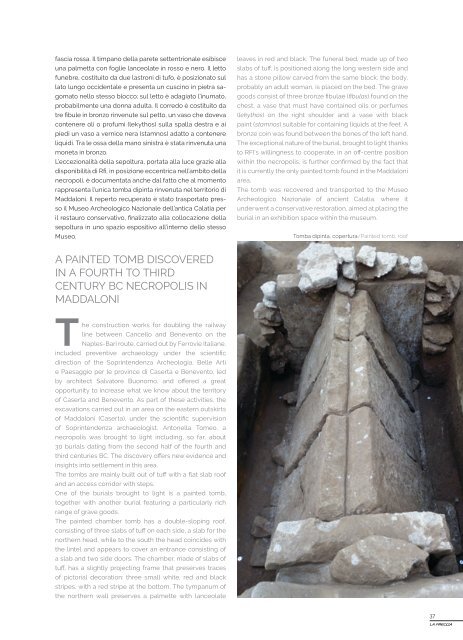You also want an ePaper? Increase the reach of your titles
YUMPU automatically turns print PDFs into web optimized ePapers that Google loves.
fascia rossa. Il timpano della parete settentrionale esibisce<br />
una palmetta con foglie lanceolate in rosso e nero. Il letto<br />
funebre, costituito da due lastroni di tufo, è posizionato sul<br />
lato lungo occidentale e presenta un cuscino in pietra sagomato<br />
nello stesso blocco; sul letto è adagiato l’inumato,<br />
probabilmente una donna adulta. Il corredo è costituito da<br />
tre fibule in bronzo rinvenute sul petto, un vaso che doveva<br />
contenere oli o profumi (lekythos) sulla spalla destra e ai<br />
piedi un vaso a vernice nera (stamnos) adatto a contenere<br />
liquidi. Tra le ossa della mano sinistra è stata rinvenuta una<br />
moneta in bronzo.<br />
L’eccezionalità della sepoltura, portata alla luce grazie alla<br />
disponibilità di Rfi, in posizione eccentrica nell’ambito della<br />
necropoli, è documentata anche dal fatto che al momento<br />
rappresenta l’unica tomba dipinta rinvenuta nel territorio di<br />
Maddaloni. Il reperto recuperato è stato trasportato presso<br />
il Museo Archeologico Nazionale dell’antica Calatia per<br />
il restauro conservativo, finalizzato alla collocazione della<br />
sepoltura in uno spazio espositivo all’interno dello stesso<br />
Museo.<br />
leaves in red and black. The funeral bed, made up of two<br />
slabs of tuff, is positioned along the long western side and<br />
has a stone pillow carved from the same block; the body,<br />
probably an adult woman, is placed on the bed. The grave<br />
goods consist of three bronze fibulae (fibulas) found on the<br />
chest, a vase that must have contained oils or perfumes<br />
(lekythos) on the right shoulder and a vase with black<br />
paint (stamnos) suitable for containing liquids at the feet. A<br />
bronze coin was found between the bones of the left hand.<br />
The exceptional nature of the burial, brought to light thanks<br />
to RFI's willingness to cooperate, in an off-centre position<br />
within the necropolis, is further confirmed by the fact that<br />
it is currently the only painted tomb found in the Maddaloni<br />
area.<br />
The tomb was recovered and transported to the Museo<br />
Archeologico Nazionale of ancient Calatia, where it<br />
underwent a conservative restoration, aimed at placing the<br />
burial in an exhibition space within the museum.<br />
Tomba dipinta, copertura/Painted tomb, roof<br />
A PAINTED TOMB DISCOVERED<br />
IN A FOURTH TO THIRD<br />
CENTURY BC NECROPOLIS IN<br />
MADDALONI<br />
The construction works for doubling the railway<br />
line between Cancello and Benevento on the<br />
Naples-Bari route, carried out by Ferrovie Italiane,<br />
included preventive archaeology under the scientific<br />
direction of the Soprintendenza Archeologia, Belle Arti<br />
e Paesaggio per le province di Caserta e Benevento, led<br />
by architect Salvatore Buonomo, and offered a great<br />
opportunity to increase what we know about the territory<br />
of Caserta and Benevento. As part of these activities, the<br />
excavations carried out in an area on the eastern outskirts<br />
of Maddaloni (Caserta), under the scientific supervision<br />
of Soprintendenza archaeologist, Antonella Tomeo, a<br />
necropolis was brought to light including, so far, about<br />
30 burials dating from the second half of the fourth and<br />
third centuries BC. The discovery offers new evidence and<br />
insights into settlement in this area.<br />
The tombs are mainly built out of tuff with a flat slab roof<br />
and an access corridor with steps.<br />
One of the burials brought to light is a painted tomb,<br />
together with another burial featuring a particularly rich<br />
range of grave goods.<br />
The painted chamber tomb has a double-sloping roof,<br />
consisting of three slabs of tuff on each side, a slab for the<br />
northern head, while to the south the head coincides with<br />
the lintel and appears to cover an entrance consisting of<br />
a slab and two side doors. The chamber, made of slabs of<br />
tuff, has a slightly projecting frame that preserves traces<br />
of pictorial decoration: three small white, red and black<br />
stripes, with a red stripe at the bottom. The tympanum of<br />
the northern wall preserves a palmette with lanceolate<br />
37

















